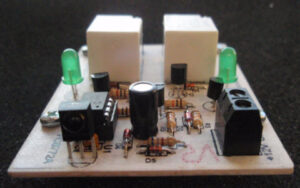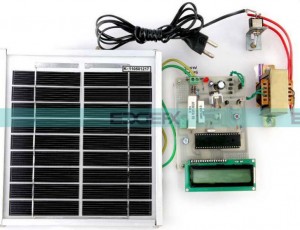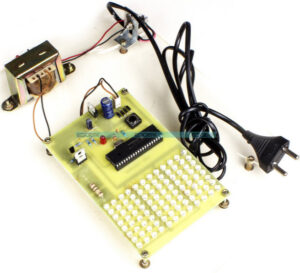Summary of PIC Microcontroller: Fundamentals & Applications for Students
The article provides a comprehensive overview of PIC microcontrollers, covering their architecture, peripherals, and programming methods using assembly and C languages via MPLAB X IDE. It explores real-world applications such as motor control, temperature sensing, and home automation, complemented by detailed interfacing circuits. Communication interfaces like USART, SPI, I2C, and CAN are explained with practical examples. The guide also highlights gaps in modern applications, including IoT integration, cloud connectivity, wireless protocols, TinyML, and security. This makes it an effective learning resource for engineering students and embedded engineers aiming to design advanced PIC-based embedded systems.
Parts used in the PIC Microcontroller Projects:
- PIC16F877A Microcontroller
- 16x2 LCD Module
- 4x4 Matrix Keypad
- SPDT Relay
- 7-Segment Display
- L293D Motor Driver IC
- Unipolar Stepper Motor
- ULN2003 Darlington Array
- LM35 Temperature Sensor
- PIR Motion Sensor
- MQ Gas Sensor
- GSM Module
- GPS Module
- Current Transformer (CT) Sensor
- Dot Matrix Display
- Various Passive Components (Resistors, Capacitors)
- Power Supply Module
Introduction
Microcontrollers are the key components in the embedded systems market. A variety of embedded systems was formed and developed after the invention of the Intel 8051 in the 1980s, where major and continuous research was exercised in the same field to produce more effective microcontrollers at low power. Some of the microcontrollers include arm, AVR, and PIC microcontrollers among others. One should also notice that these microcontrollers ensure the usage of necessary communication channels I2C, USB, SPI, CAN, Ethernet, and others, which makes these microcontrollers much more suitable for current usage. In 1998, Microchip Technology introduced advanced PIC microcontroller architectures with enhanced onboard peripherals, boosting their performance and market relevance.
The PIC microcontrollers are economically designed with RISC-like like the design of the microprocessor hardware platform and are ideal for use in the industrial segment due to their high efficiency and low power consumption capabilities. In this regard, this product has the primary goal of delivering all the information regarding PIC microcontrollers and how they can be used in engineering to engineering students.

PIC Microcontroller Basics
This section of the product covers the fundamental aspects of PIC microcontrollers. PIC microcontrollers are Harvard architecture CPUs that have separate program and data memories. They have a wide range of devices available with varying memory sizes and peripherals. The basic architecture consists of a CPU, control unit, register file, program memory, data memory, and I/O ports.
The CPU executes instructions from the program memory sequentially. It has a RISC-like instruction set for efficient execution. The control unit manages the flow of instructions by fetching, decoding, and executing them. General-purpose registers are used for data manipulation and address calculations. Different PIC models come with varying combinations of RAM, ROM, EEPROM, and specialized registers.

Some key aspects of the PIC instruction set are covered. Instructions are 14/16-bit long and most have a single-cycle execution time. Common operators like ADD, MOV, CLR, INC, and DEC are supported. Conditional and unconditional branching allows flexible program flow control. Other concepts explained are interrupts, stacks, timers, counters, and analog and digital I/O. Overall, this section provides a solid foundation for the basic PIC microcontroller architecture.
Programming PIC Microcontrollers
This chapter delves into programming PIC microcontrollers. The product discusses in detail about assembly level programming using MPLAB X IDE and MCC (Microchip Code Configurator). Key steps like code writing, assembling, linking, and debugging are covered. Programming modes like in-circuit serial programming (ICSP) and debug interfaces are explained.
- MPLAB X IDE with the XC8 compiler is widely used for PIC microcontroller programming. High-level programming options like MikroC, mikroBasic, and PIC C are also explored, with examples provided for efficient programming.
High-level programming of PICs is gaining popularity due to its ease of use. The book explores options like MikroC, mikroBasic, and PIC C compilers. It covers the basics of these compilers, integrated development environment, libraries available, and programming workflow. Concepts like pragma directives, and interrupt service routines are explained with examples. Both assembly and C programming examples are provided to reinforce understanding.

PIC Applications
The book includes several chapters dedicated to real-world applications of PIC microcontrollers. Example applications covered are motor control, temperature monitoring, LCD interfacing, keypad interfacing, seven-segment display, dot matrix display, relay control, DC motor speed control, stepper motor control, and more. Detailed circuit diagrams and sample codes are provided for each application.
Some other projects explored are IR remote control, power monitoring using CT sensors, light & temperature sensing street light control, wine level monitoring, burglar alarm, smart home automation, and more. Communications-based applications like GSM/GPS-based vehicle tracking and SMS alert systems are demonstrated. Finally, the concepts are summarized and guidelines are provided to select appropriate PIC for custom applications.
In summary, this product offers comprehensive yet practical knowledge of PIC microcontroller architecture, programming, and peripheral interfacing through real examples. Both assembly and C programming approaches are discussed. The applications chapters provide hands-on experience in utilizing PIC microcontrollers to interface with electronics modules and build embedded projects. This makes it an excellent learning guide for engineering students and embedded engineers.
PIC Microcontroller Peripherals
This section provides an in-depth look at common onboard peripherals available on PIC microcontrollers. Timers and counters are explained as they are used for various timing applications. Working on different timer modes and how to configure them is demonstrated. Analog to digital converters are covered detailing the working principles and applications. Serial communication interfaces like USART, SPI, and I2C are elaborated with programming samples. Other peripherals covered are watchdog timer, PWM, capture/compare modules, etc. This gives the reader comprehensive knowledge about leveraging various hardware capabilities.
PIC microcontrollers integrate a range of useful onboard peripherals that expand their capabilities. This section provides detailed explanations of commonly available peripherals:
Timers
PIC microcontrollers contain multiple timers/counters that are flexible and useful for various timing applications. The different timer modules – Timer0, Timer1, Timer2, and Timer3 are discussed.
Each timer can be configured to work in different modes like timer, counter, pulse width modulation, etc. Timer modes covered include 16-bit timer, 8-bit timer, counter, split timer/counter, etc. Programming samples are given for interval timing, event counting, PWM generation, etc.
Analog to Digital Converter
The onboard ADC module converts analog sensor signals into digital numbers. The 10-bit resolution ADC on PIC16F877A is explained in detail. Sample-and-hold concept, reference voltage selection, voltage inputs, channel selection, and conversion trigger sources are covered. Applications like temperature measurement, light sensing, and voltage measurement are demonstrated.
Serial Communication
Popular serial protocols allow data transfer between PIC and other devices. USART, SPI, and I2C interfaces available on PICs are discussed. Configuring baud rates, data formats, and interrupt handling for USART. SPI Master/Slave operation with programming examples. I2C protocol, and master/slave addressing schemes are elaborated.
Other Peripherals
Other peripherals like watchdog timers, GPIO pins, PWM, CCP modules, etc are also covered. Watchdog timer operation and configuration for program supervision. How to configure GPIO pins as digital inputs/outputs with internal/external pull-ups. The pulse width modulation mode of the timer is explained. Applications of capture/compare peripheral.
This section provides a clear understanding of diverse onboard peripherals and how to program them. This expands the application scope and teaches advanced features that are useful for complex embedded designs.
PIC Microcontroller Interfacing and Applications
This part details the practical interfacing of PIC microcontrollers with external devices and modules. Sample application circuits and programs are presented to demonstrate the interfacing concepts.
Keypad Interfacing
4×4 matrix keypad interfacing is demonstrated using PIC16F877A. The debouncing mechanism, scanning rows, and reading columns are explained. The key detection algorithm and usage of the switch case are shown.
LCD Interfacing
16×2 LCD module interfacing using 4-bit mode and 8-bit mode is described. LCD initialization sequence, writing commands, Clear Display, cursor positioning, and data display are covered.
Relay Control
Applications of controlling high power loads are shown through SPDT relay interfacing. Sample programs for ON/OFF control of AC appliances using ports are explained.
Seven Segment Display
Interfacing of 7-segment display for numerical display. Individual segment control using port pins, and common anode/cathode configurations are discussed. Decimal point, blinking patterns are demonstrated.
Motor Control
L293D motor driver IC interfacing for DC motor speed and direction control is explained. The timer is used to generate PWM for variable speed. Concepts of H-bridge are briefly covered.
Stepper Motor Control
Four-phase unipolar stepper motor interfacing using ULN2003 Darlington array is described. Micro-stepping is explained and a sample program for half-stepping sequence is provided.
Temperature Measurement
LM35 temperature sensor interfacing to measure ambient temperature. ADC conversion and calculation of temperature in degrees Celsius are demonstrated.
Home Automation
Design of a smart home automation system using a PIR motion sensor, MQ gas sensor, relay, and GSM module along PIC microcontroller. Real-life systems operating various appliances detect these events. This section imparts practical knowledge on interfacing PIC with digital and analog ICs as well as sensors. The application circuits help understand concepts with a hands-on approach.
PIC Microcontroller Communication Interfaces
Microcontrollers have evolved with integrated communication interfaces that expand applications in industrial and IoT domains. This section examines popular serial communication interfaces on PIC microcontrollers:
Lack of Practical Examples for Modern Applications
While PIC microcontrollers have long been used in traditional embedded applications, many modern industries now require features that extend beyond basic microcontroller functionalities. A significant limitation of many learning resources and guides is the lack of examples that address these contemporary needs. As embedded systems evolve, engineers increasingly need practical examples that showcase how PIC microcontrollers can be integrated into the following modern use cases:
IoT Integration and Connectivity
Although PIC microcontrollers are widely used in traditional applications, they often lack thorough practical examples for integrating with IoT devices and cloud-based platforms. The addition of wireless protocols like Wi-Fi, Bluetooth, or LoRaWAN is becoming crucial. Real-world examples demonstrating PIC integration with cloud services like AWS or Azure are scarce.
Cloud-Based Data Processing and Analytics
Embedded systems today often require remote data logging and real-time analytics. There is a growing need for examples showing how to interface a PIC microcontroller with cloud platforms for data collection, storage, and analysis—using APIs or other web services.
Wireless Communication Beyond Basic Protocols
Modern communication standards such as Zigbee, NB-IoT, and 5G are essential for many industrial and IoT applications. While PIC microcontrollers offer basic wireless communication (like UART or SPI), practical applications involving these advanced wireless protocols remain underrepresented.
Machine Learning on Edge Devices (TinyML)
With the rise of machine learning in embedded systems, edge computing is becoming a key area for microcontrollers. PIC resources generally lack practical examples that involve on-chip machine learning algorithms (TinyML), which can process data locally without the need for cloud services.
Security Features for Modern Embedded Systems
Security is a growing concern in embedded systems, especially with the increasing prevalence of connected devices. Practical examples showing how to secure PIC-based systems with features like encryption, secure boot, and over-the-air (OTA) firmware updates are not widely available.
Power Management and Energy Harvesting
Modern applications often require ultra-low power designs with features like energy harvesting. Despite the potential, practical implementations of efficient power management strategies using PIC microcontrollers are not well-documented.
Modern Sensors and Actuators
As sensor technology advances, PIC microcontrollers need to interface with modern sensors that go beyond the simple analog and digital types. Examples involving sensors like MEMS, LIDAR, or advanced environmental sensors (such as for air quality or weather forecasting) are missing from many resources.
By addressing these gaps, educators and engineers could significantly enhance the relevance of PIC microcontroller applications in today’s rapidly changing technology landscape.
USART
Universal synchronous/asynchronous receiver transmitter hardware and programming concepts are explained. Asynchronous communication, baud rate generation, and interruption in reception/transmission are covered. USART data transfer code samples.
I2C
Inter-integrated circuit protocol details like bus topology, address schemes, data transfer, and multi-master mode. Sample programs for master and slave code with addressing. EEPROM data read/write.
SPI
Serial peripheral interface functional overview with bus configuration, CS pin, master/slave modes, clock polarity/phase. Writing to and reading from SPI devices like ADCs with code samples.
CAN
Controller area network protocol architecture, frame formats, error detection, arbitration, mailboxes, message buffers, and acceptance filtering. Usage for vehicle bus applications.
Other Interfaces
Additional communication options for PICs like UART, USB 2.0, and Ethernet modules are described at a high level.
Applications
Real designs for interfacing the GSM module, GPS module, and temperature/humidity sensor with communication over USART/SPI/I2C are discussed including circuit and code. The concept of using a microcontroller as a slave device is also explained. This section imparts practical knowledge on using communication interfaces to transfer data between devices in embedded networks. It prepares students to work on Industrial IoT solutions.
Conclusion
n conclusion, this guide serves as a thorough and practical resource for students and engineers to master PIC microcontroller concepts, from basic architecture to advanced programming techniques. It covers essential topics like MPLAB X IDE, timers, communication interfaces, and peripherals, offering hands-on examples that prepare learners for both academic and real-world applications. Expanding into IoT, security, and modern embedded applications, this guide offers a complete foundation for developing custom PIC-based solutions and addressing the evolving needs of the embedded systems industry.
Detailed knowledge of various onboard peripherals and their programming help understand advanced features. The interfacing chapters present hands-on experience of using PIC microcontrollers in real applications dealing with keypads, displays, sensors, motor control, etc. Communication interfaces expand applications from isolated designs to networked embedded systems. With sufficient theory, programming examples, and real application circuits, this book equips learners with skills relevant to working on PIC-based industrial projects as well as further higher studies in the embedded systems domain. The concepts covered are sufficient to develop custom solutions using diverse PIC microcontroller families. Overall, this serves as an excellent self-study guide or as a recommended textbook for embedded systems courses.
